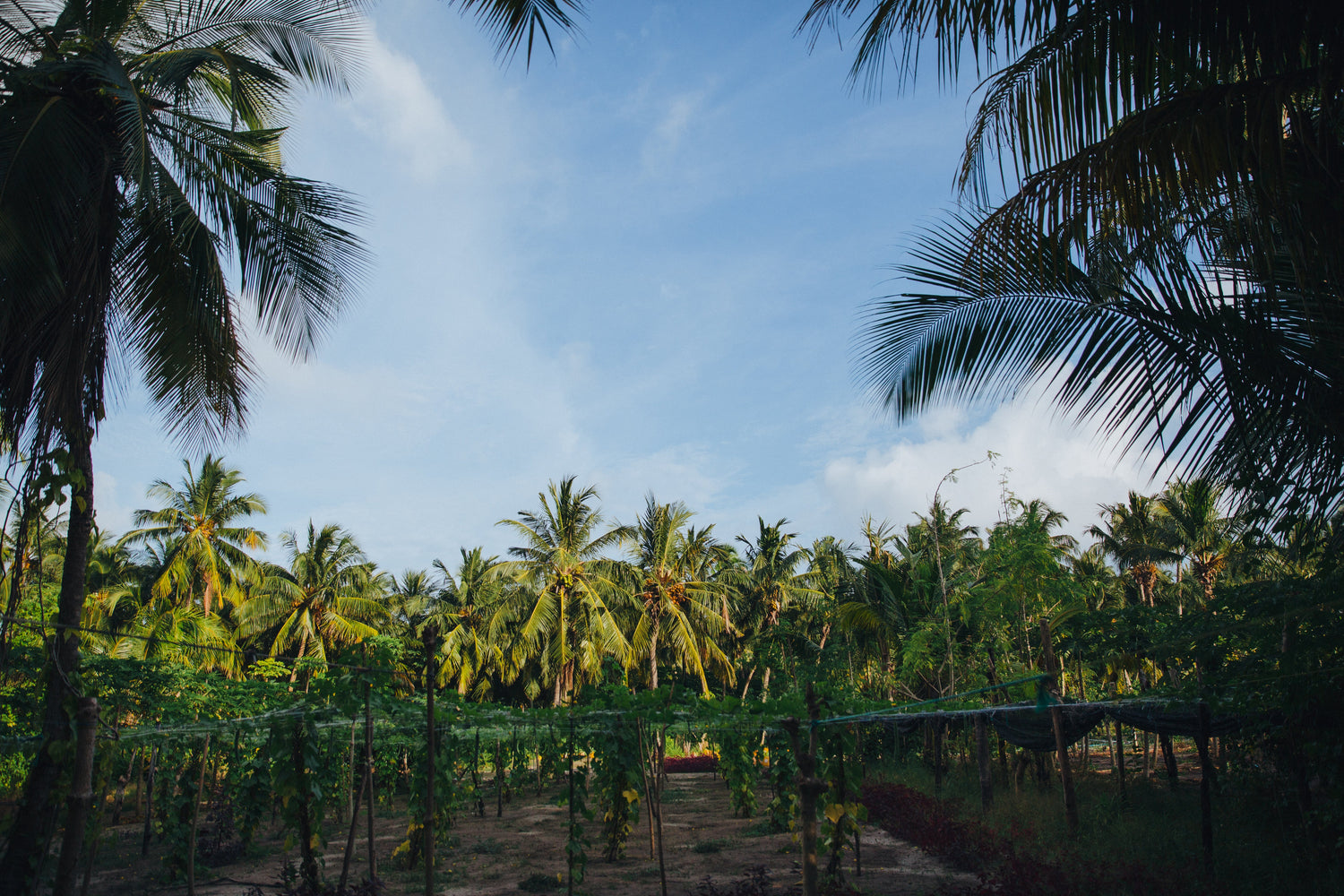Cropping/farming systems
Integrating coconut plantations with compatible subsidiary crops and livestock can significantly enhance productivity and net returns. By utilizing farm resources like land, labor, sunlight, water, and nutrients more effectively, the productivity of the system benefits from the synergistic interactions between the crops and livestock components. Including a diverse range of annual, biennial, or perennial crops as inter/mixed crops within the coconut plantation also promotes sustainability.
Coconut monocropping does not fully utilize the soil and sunlight available in the garden. The growth habits and planting methods of coconut make it highly suitable for intercropping in the spaces between the trees. Coconut palms have a typical adventitious root system, with 4,000 to 7,000 roots in middle-aged palms under favorable conditions. About 74% of these roots do not extend beyond a 2-meter lateral distance, and 82% are confined to the soil depth of 31 to 120 cm. This means that only 25% of the available land area is used by the coconut roots, leaving the remaining area for profitable subsidiary crops. The leaf orientation in the coconut crown allows sunlight to penetrate the soil, enabling inter/mixed cropping. The choice of crops should be based on the age of the palms, crown size, sunlight availability, and regional agro-climatic conditions.
Intercropping is viable in the initial growth stage of the palms, while mixed cropping becomes suitable in later stages. Various intercrops can be grown in coconut gardens for the first 5 to 7 years, including tubers and rhizomatous spices (tapioca, elephant foot yam, sweet potato, greater yam, lesser yam, Chinese potato, colocasia, ginger, turmeric), cereals and millets (paddy, sorghum, maize, pearl millet, finger millet), pulses and oilseeds (cowpea, green gram, black gram, red gram, groundnut, soybean, Bengal gram, sunflower), vegetable crops (pumpkin, ash gourd, chilies, potato, French bean, snake gourd, amaranthus, brinjal, bottle gourd, ridge gourd, coccinia, Dolichos bean, annual moringa, curry leaf, tomato), fruit crops (banana, pineapple, papaya), flowering crops (heliconia, anthurium, jasmine), and fodder grass and legumes.

During the second growth phase (5-20 years), growing other crops in the interspaces may be challenging due to limited sunlight. However, shade-tolerant crops like colocasia, certain banana varieties (Robusta, Grand Naine, Palayamkodan), fodder grass, and shade-loving medicinal plants can be cultivated.
Once the palms reach a height of 5 to 6 meters (above 20 years), the initial intercrops and perennials like cocoa, vanilla, black pepper, cinnamon, clove, nutmeg, sapota, and medicinal and aromatic crops (Chittadalodakam, Karimkurinji, Nagadanthi, vetiver, Indian long pepper) can be grown as mixed crops. Perennials are recommended as intercrops in this third stage only when coconut spacing is 7.5 to 8.0 meters. Alternatively, perennials can be planted from the initial stage with wider coconut spacing (10 meters and above). In areas with uneven rainfall distribution, irrigation is necessary during the summer months. Additionally, these crops should be adequately and separately fertilized along with the coconut palms, following the recommended practices by regional agricultural universities.
High Density Multispecies Cropping System
The High-Density Multispecies Cropping System (HDMSCS) is a farming approach designed to grow a variety of crops that cater to the diverse needs of farmers, such as providing food, fuel, timber, fodder, and cash. This system is particularly effective for smaller land units, as it focuses on maximizing production per unit area and time while promoting sustainability. HDMSCS includes a mix of annual, biennial, and perennial crops, encompassing cash crops, food crops, and fodder crops. Additionally, all biomass, aside from the economically valuable parts, is recycled within the system.
From experiments conducted at the CPCRI Kasaragod with a plot featuring coconut trees alongside banana, pineapple, pepper, clove, and nutmeg, it has been found that this system can generate an average annual net income of 5 to 6 lakh rupees per hectare. Furthermore, the system produces 25 tonnes of organic waste per hectare, which can be recycled and used as vermicompost for the crops. By effectively recycling organic matter in HDMSCS, the need for chemical fertilizers for coconut can be reduced to two-thirds of the recommended dose.
Coconut based integrated farming system
Coconut-based integrated farming is an ecologically sustainable approach that helps farmers increase their income while optimizing the use of resources. The goal of this system is to enhance production by efficiently utilizing inputs and protecting the environment. Incorporating mixed farming techniques, such as growing fodder grasses like hybrid Napier or guinea grass alongside leguminous crops like Stylosanthes gracilis in coconut gardens, has proven to be profitable. For instance, cultivating these crops on one hectare of coconut land can support five to six dairy animals. Moreover, growing Hybrid Bajra Napier (Co 3, Co 4, or Co 5) as an intercrop can yield about 120 tonnes of green fodder per hectare annually, enough to sustain 12 animals.Additionally, farmers can integrate other activities such as poultry, fish farming (pisiculture), goat farming (goatery), and beekeeping (apiculture) based on their interests. The manure from cattle and poultry can significantly improve soil fertility when applied to coconut gardens.

Maintaining dairy cows and other elements in a coconut garden not only increases income but also provides additional employment opportunities for the farmer's family. For example, a one-hectare coconut-based mixed farming unit, including 10 dairy cows, 6 batches of 100 poultry birds each, Co 3 Hybrid Bajra Napier fodder grass, 1,000 fingerlings, and a goat unit with 20 does and 2 bucks, can generate a net income of 6.0 to 6.5 lakh rupees per year. Such a unit also creates approximately 900 man-days of employment annually.This integrated system produces over 70 tonnes of farmyard manure (FYM) and more than 1 lakh liters of cow urine, which, when recycled into the system, enhance the soil's physical, chemical, and biological properties, ensuring sustainability. By utilizing on-farm resources, more than 75% of the nitrogen and potassium requirements and the entire phosphorus requirement can be met internally.
